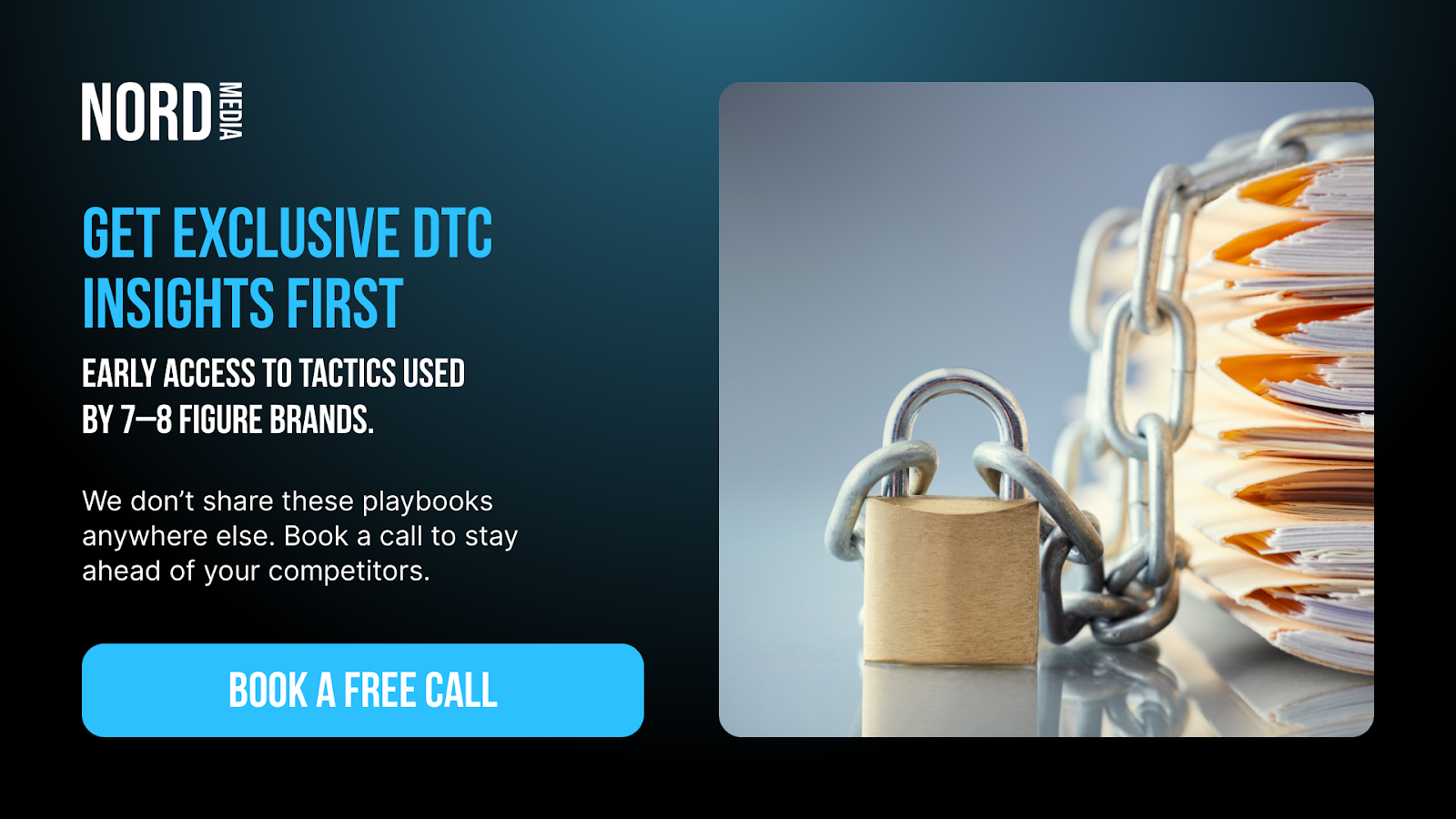Key Takeaways:
- Facebook funnels drive long-term growth: They move prospects from awareness to conversion to loyalty, making each click count.
- Data and creative alignment are essential: Pixel + CAPI tracking, precise segmentation, and scroll-stopping creative power predictable ROI.
- Optimization never stops: Test, measure, and refine every stage of your funnel to turn traffic into loyal, high-value customers.
Every click on Facebook is a potential customer, but only if you have a system to guide them from casual interest to committed purchase. Too many brands treat ads like one-off shots, hoping a flashy creative will do all the work. In reality, growth comes from building structured Facebook funnels that move people intentionally through each stage of the buyer’s journey.
At Nord Media, we’ve managed millions in ad spend for DTC and ecommerce brands, and the difference between scaling profitably and stalling out usually comes down to funnel design. When your ads, audiences, and offers are aligned, you don’t just buy traffic, you build a predictable engine for revenue.
This guide provides a pragmatic, step-by-step blueprint for constructing Facebook funnels that deliver measurable, compounding growth, not just a temporary bump in traffic.
What Is A Facebook Funnel And How Does It Work?
A Facebook funnel is a structured, multi-step process that systematically guides potential customers from discovering your brand to becoming loyal buyers, all within the Facebook and Instagram ecosystem. Unlike scattered or one-off ad campaigns, a well-engineered Facebook funnel leverages data and creative to deliver the right message to the right person at the right time, generating profitable conversions at scale.
Top Of Funnel: Capturing Attention
This stage focuses on broad outreach and brand awareness. Here, your primary objective is to stop the scroll with compelling creative and introduce your offer or solution to prospects who may have never heard of your brand. Video ads, engaging stories, and strong hooks perform best, designed to drive high-volume traffic into your ecosystem.
Middle Of Funnel: Building Connection
Now, you’re speaking to users who have interacted with your brand but haven’t yet converted. The goal: nurture their interest. Deploy retargeting campaigns to re-engage past website visitors or social engagers with social proof, product benefits, and more targeted messaging. Lead magnets, testimonials, and user-generated content build credibility and trust where it matters most.
Bottom Of Funnel: Driving Conversion
At this final stage, focus on closing the deal. Your audience has shown repeated interest, so the messaging is all about urgency and value. Use dynamic product ads, exclusive offers, and limited-time discounts to pull fence-sitters across the finish line. Integrate frictionless checkout experiences and clear calls to action to maximize conversions.
Post-Purchase: Maximizing Customer Value
The funnel doesn’t end after a customer buys. Use follow-up campaigns to encourage repeat purchases, upsells, and referrals. Loyalty programs, product education content, and timely remarketing reinforce your brand relationship and increase lifetime value.

How Facebook Funnels Turn Cold Clicks Into Loyal Customers
Efficient Facebook funnels are engineered systems that move users from curiosity to conversion, even if they’ve never heard of your brand. Here’s how real operators leverage each stage for measurable, sustainable growth.
Building Awareness Through Thumb-Stopping Creative
The journey starts by capturing attention. Creative assets are designed to interrupt the social scroll. Relevant visuals, razor-sharp headlines, and clear messaging are tailored to speak directly to your audience’s pain points and aspirations. Every asset is methodically tested to maximize engagement from the first impression.
Nurturing Interest With Precise Sequencing
Once you’ve earned a click, retargeting sequences step in. These aren’t random ads, they’re targeted touchpoints, gradually delivering value: educational videos, testimonials, and key offers that address objections. This layered messaging guides prospects deeper into your funnel, converting surface-level curiosity into serious consideration.
Driving Action With Frictionless Conversions
Clear CTAs, mobile-optimized landing pages, and seamless checkout processes remove all barriers to purchase. Each step is scrutinized to remove unnecessary friction; every second shaved off means higher conversion rates. Dynamic product feeds and tailored incentives ensure your warmest leads take action fast.
Cementing Loyalty Post-Purchase
The funnel doesn’t end at the sale. Automated follow-ups, exclusive offers, and targeted content for recent buyers keep your brand at the top of your mind, driving retention and repeat purchases. Smart segmentation lets you continuously nurture new advocates, unlocking high-lifetime-value customers at scale.
Building The Foundation Of A High-Converting Facebook Funnel
A successful Facebook Funnel is like constructing a sturdy building; its strength depends entirely on the foundation. Before writing ad copy or selecting audiences, you must lock in your technical setup, ensure flawless data tracking, and deeply understand the customer journey. Skip this stage, and your funnel will collapse under the weight of increased ad spend.
Essential Foundational Elements
The Facebook Pixel And Server-Side Tracking (Conversions API)
Your tracking infrastructure is the nervous system of your funnel. Without clean, accurate data, Meta’s algorithm can’t optimize for conversions, and you’re essentially flying blind.
The Pixel
- Install the base Facebook Pixel correctly on every page of your site.
- Verify that standard events (View Content, Add to Cart, Initiate Checkout, Purchase) are firing properly.
- Ensure all events capture the correct values (e.g., purchase amount).
The Conversions API (CAPI)
- Privacy updates (like iOS 14.5+) make Pixel-only tracking insufficient.
- CAPI enables server-to-server event tracking, ensuring stability.
- Benefits: higher match rates, more reliable attribution, and stronger algorithm optimization.
- Non-negotiable: implement both Pixel + CAPI together for data accuracy.
Defining Your Customer Journey And Value Ladder
You can’t build a funnel without clarity on the buyer’s path. Every touchpoint should guide prospects toward becoming loyal customers.
Map the Journey
- Cold Traffic → Warm Prospect (watching a video, visiting a product page).
- Warm Prospect → Hot Lead (adding to cart, initiating checkout).
- Hot Lead → Customer (completing a purchase).
Design a Value Ladder
- Cold audiences: Offer low-commitment entry points (educational content, free trial, lead magnets, small-ticket items).
- Warm audiences: Introduce mid-tier offers (discounts, bundles, testimonials).
- Hot audiences: Present your core product with urgency-driven calls to action.
Setting Up Custom And Lookalike Audiences
The true power of Facebook Funnels lies in segmentation, delivering the right message to the right people at the right time.
Custom Audiences (Retargeting)
- Website Visitors: Segment by recency (e.g., 7-day vs. 90-day) or intent (e.g., product viewers vs. add-to-cart).
- Engagement: Build from users who watched 75%+ of your videos or engaged with your social profiles.
- Customer Lists: Upload your buyers and segment by lifetime value (LTV) for precise retargeting or exclusion.
Lookalike Audiences (Prospecting)
- Generate high-quality Lookalikes from your most valuable data sources (purchasers, repeat customers, highest LTV segments).
- Start with 1% Lookalikes for precision, then expand to 2–5% for broader reach.
- Let the algorithm model from your best data, not just broad traffic.
Essential Stages Of Facebook Funnels You Can’t Ignore
Each stage is a tactical lever. Miss one, and you’re leaving revenue on the table. Here’s where to focus:
Top-Of-Funnel: Capture Attention
Start wide. Aim for maximum reach using creative that stops the scroll. Prioritize thumb-stopping visuals, bold copy, and clear value props. Your mission: build genuine interest and introduce your brand to new, qualified prospects.
Middle-Of-Funnel: Nurture & Educate
Retarget engaged users with deeper messaging. This is your chance to address pain points, showcase proof, and offer value-led content, such as testimonials, case studies, or product demos. Build trust while moving prospects closer to a buying mindset.
Bottom-Of-Funnel: Drive Conversion
Now’s the time to convert intent into action. Deploy strong calls-to-action, exclusive offers, and frictionless buying experiences. Serve high-conviction messages to warm audiences, making it easy for them to say “yes.”
Post-Purchase: Lock In Loyalty
Don’t stop at the sale. Retarget buyers with upsells, personalized follow-ups, and referral incentives. Build advocacy and drive repeat purchases—this is your lever for compounding growth.

Creative And Copywriting That Powers Facebook Funnels
Effective Facebook funnels are built on scroll-stopping creative and strategic copywriting. Execution here isn’t about chasing likes but pushing prospects from attention to action.
Scroll-Stopping Visuals
Your visuals are the frontline. High-contrast images, dynamic video, and brand-consistent aesthetics are essential. Every asset must capture attention in seconds and hold relevance at each funnel stage.
Messaging That Converts
Clarity crushes cleverness. Compelling headlines, direct value props, and urgency-oriented calls to action fuel movement down the funnel. Every line should bridge curiosity and conversion.
Personalization At Scale
Successful funnels leverage audience signals for messaging that feels one-on-one, not broadcast. Dynamic creative variations and personalized angles keep relevance high and fatigue low.
Rapid Creative Testing
Iterate, don’t assume. Build testing frameworks that quickly identify winning elements. Let data dictate direction, removing the guesswork and bias from creative decisions.
Tracking, Metrics, And Optimization For Facebook Funnels
A high-performing Facebook funnel isn’t built on guesswork; it’s engineered around clear metrics, disciplined tracking, and continuous optimization. Here’s how to cut through the noise and build for durable ROI.
Key Metrics To Monitor
- Customer Acquisition Cost (CAC): Measure your spending on each new customer. Lower CAC signals more efficient funnel stages.
- Conversion Rate: Track percentage of users who move from click to purchase or lead. Drops pinpoint where prospects are leaking out.
- Lifetime Value (LTV): Prioritize recurring value, not just one-time sales. LTV:CAC ratio clarifies if your funnel is actually delivering profitable growth.
- Click-Through Rate (CTR): Highlights if your creative and messaging resonate at the top of the funnel, not just generating empty traffic.
- Return on Ad Spend (ROAS): Beyond vanity numbers; only the net return tied to spend matters.
Implementing Tracking Infrastructure
- Use Meta’s pixel and Conversions API to capture both broad and granular events.
- Integrate with analytics tools for end-to-end attribution.
- Set up custom events to track on-site actions central to your revenue drivers.
Continuous Optimization Framework
- A/B constantly tests creative, audiences, and landing pages; don’t assume, validate.
- Segment audiences to personalize messaging at every stage of the funnel.
- Shift budget dynamically to the highest-performing ad sets and funnel stages.
- Audit funnel performance weekly, prune underperforming elements fast.
Turning Insights Into Action
- Tie optimizations directly to core metrics, change for the sake of impact, not experimentation.
- Set explicit, actionable KPIs for each funnel phase to track real movement against your business goals.
- Build feedback loops between creative and performance data for compounding improvements.
Scaling Facebook Funnels For Sustainable Business Growth
Building a high-performing Facebook funnel is only step one. Scaling that funnel into a sustainable growth engine requires a systematic, operator-driven approach focused on delivering measurable and repeatable results over time.
Optimize For Conversion Efficiency
Efficient spend is non-negotiable. Continuously test creative variations, landing pages, and offers to improve conversion rates. Remove underperforming segments fast, capitalize on what’s working to maximize profitability, not just reach.
Deepen Audience Segmentation
Go beyond broad targeting. Segment audiences by value, behavior, and lifecycle stage. Layer custom audiences and lookalikes on top of first-party data. This precision cuts wasted budget and sharpens messaging, compounding downstream ROI.
Relentless Creative Iteration
Your funnel is only as strong as your creative. Systematically rotate new scroll-stopping concepts and formats, measure real impact, and retire creative fatigue early. Treat creative as a core growth lever, not an afterthought.
Expand And Diversify Channel Inputs
Test new placements and formats within Facebook’s ecosystem, stories, reels, messages. When performance plateaus, layer in cross-channel retargeting to reinforce campaigns and recapture lost prospects at every touchpoint.
Double Down On Data And Attribution
Track beyond surface-level metrics. Leverage robust attribution modeling to identify pocketed wins and allocate budget with surgical precision. Let compounding growth guide where to invest next, always anchored to true business outcomes.

Final Thoughts
Building a high-converting Facebook funnel isn’t about throwing money at ads and hoping for results; it’s about crafting a deliberate, data-driven journey that guides customers from first touch to lifelong loyalty. By aligning creative, targeting, and tracking, you transform clicks into predictable revenue growth. Whether scaling a DTC brand or fine-tuning your ecommerce campaigns, a structured funnel gives you the control and clarity to maximize conversions and lifetime value.
Read also:
- The Ultimate Ecommerce Growth Strategy: How To Scale Profitably In 2025
- What Is Paid Media And Why It’s Essential For Scaling Your Online Store
- Facebook Ads Vs Google Ads: Performance Benchmarks For Ecommerce Marketers
Frequently Asked Questions About Facebook Funnels: The Complete Guide To Turning Clicks Into Customers
What is the best way to target the right audience on Facebook?
Precision targeting drives every high-performing Facebook funnel. Start with lookalike audiences built from your most valuable existing customers, then test broader interest-based and behavioral segments to discover new pockets of potential buyers. Layer demographic filters and leverage Facebook’s data to exclude irrelevant profiles. Don’t rely on guesses; use real customer data and ongoing performance analysis to refine your targeting systematically.
How can I track conversions through my funnel?
Facebook’s native tracking infrastructure, Pixel, Conversions API, and Events Manager, gives you the baseline, but true funnel clarity requires deeper integration. Map key conversion events to every stage, from initial click through to purchase or sign-up. Use UTM parameters for clear source attribution and integrate with your CRM or analytics suite (like Google Analytics 4) to capture, analyze, and tie campaign performance back to revenue.
What tools help manage Facebook funnels?
Streamlined funnels demand robust tools. Use Facebook Business Manager for campaign orchestration and audience building, and integrate your CRM (HubSpot, Klaviyo, or the platform that fits your stack) for automated lead nurturing and segmentation. Creative tracking platforms, dashboard tools like Looker Studio, and advanced attribution software (e.g. Triple Whale or Northbeam) round out your toolkit, enabling real-time decision-making, transparent reporting, and scalable growth.
How do I optimize each stage of my funnel?
Start with the data, not intuition: Analyze where drop-offs occur, which creatives outperform, and which audiences stick. Top-of-funnel (TOF): Prioritize virality and thumb-stopping visuals. Middle-of-funnel (MOF): Hit hard on education, trust signals, and unique selling points. Bottom-of-funnel (BOF): Deploy urgency, offers, and tailored objections handling. Continuous creative testing and budget reallocations, powered by real conversion data, turn each stage into a refined, results-driven machine.
What content should I use at the top of my Facebook funnel?
TOF content must break scrolling inertia. Think bold, visually-arresting ads, value-packed educational hooks, and clear emotional triggers that resonate with your ideal customer’s needs or pain points. Short-form video, punchy carousels, or eye-catching animations lead the charge. The goal isn’t the hard sell; it’s driving relevance and engagement that primes your audience for future touches further down the funnel.
How do I nurture leads using Facebook?
Effective lead nurturing bridges initial interest and conversion. Use sequenced retargeting campaigns and dynamic creative to address doubts, highlight social proof, and surface deeper benefits over time. Supplement ad flows with Messenger bots or lead forms paired to your email/SMS workflows for multi-channel nurturing.












